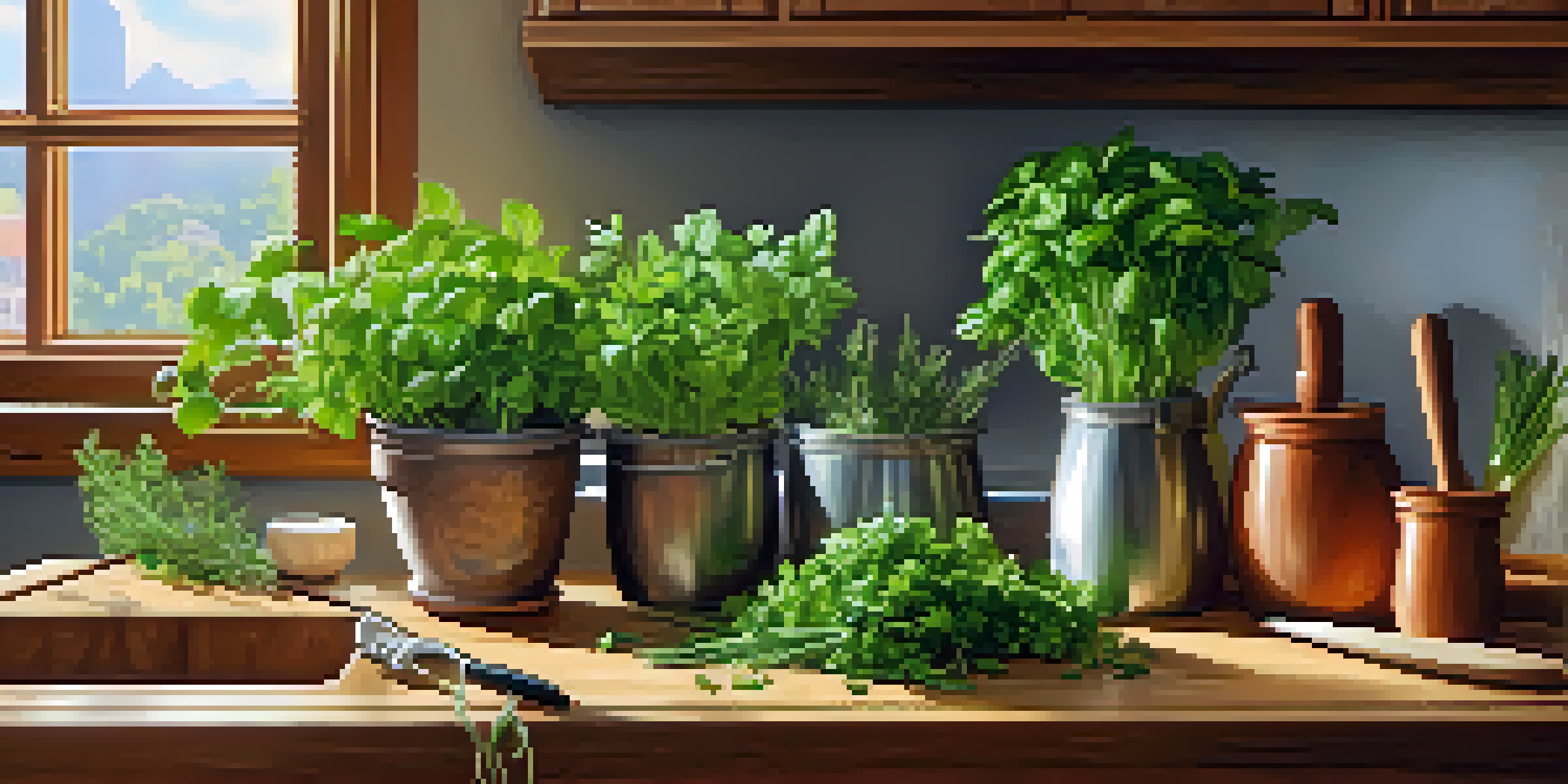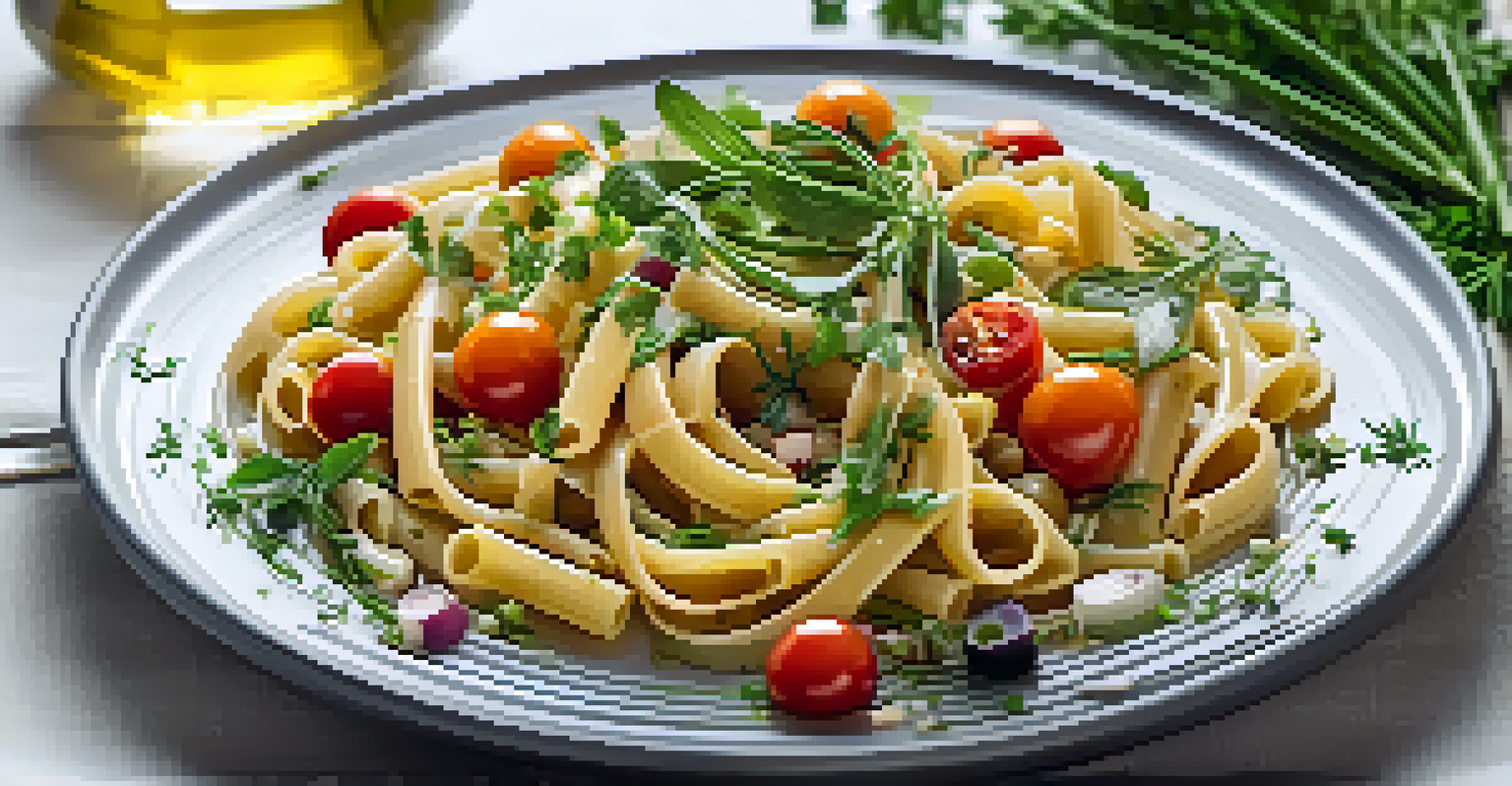The Art of Herb Blending for Vegan Cooking Success

Understanding the Basics of Herbs in Vegan Cooking
Herbs are the backbone of flavor in any dish, especially in vegan cooking. They can transform a bland meal into a vibrant feast, adding depth and aroma. From basil to thyme, each herb brings its own unique taste profile, making it essential to understand their characteristics.
Herbs are the spice of life.
When cooking vegan, you often rely on herbs to compensate for the absence of meat and dairy flavors. For instance, fresh cilantro can add a refreshing zing to a hearty bean salad, while rosemary can bring warmth to roasted vegetables. By knowing how to pair these herbs with your ingredients, you can create dishes that are not only tasty but also visually appealing.
Additionally, understanding the difference between fresh and dried herbs is crucial. Fresh herbs tend to have a more intense flavor, while dried herbs are more concentrated. This distinction can help you determine how much to use, ensuring you achieve the perfect balance in your vegan recipes.
Selecting the Right Herbs for Your Dish
Choosing the right herbs for your dish can feel overwhelming, but it doesn't have to be. Start by considering the primary ingredients of your recipe. For example, if you're making a tomato-based sauce, herbs like oregano and basil would complement it beautifully.

Another helpful tip is to think about the cuisine you're aiming to replicate. Mediterranean dishes often feature herbs like dill and parsley, while Asian-inspired recipes might call for cilantro or lemongrass. This approach not only guides your herb selection but also enriches your cooking experience.
Herbs Enhance Vegan Flavor
Herbs are essential in vegan cooking, transforming dishes with their unique tastes and aromas.
Experimentation is key! Don't be afraid to try new combinations or swap herbs based on what you have on hand. You might discover that dill works surprisingly well with roasted carrots, or that mint adds a delightful twist to a chickpea salad.
The Importance of Balancing Flavors
Balancing flavors is essential when blending herbs in vegan cooking. The goal is to achieve harmony, where no single flavor overpowers the others. Think of it like composing a piece of music; each herb plays a different note that contributes to the overall melody.
Cooking is like love. It should be entered into with abandon or not at all.
To create this balance, consider the intensity of each herb. For example, strong herbs like sage or tarragon should be used sparingly alongside milder herbs like chives or parsley. A good rule of thumb is to start with less and gradually add more until you reach your desired flavor profile.
Don't forget about the other elements in your dish, such as acidity and sweetness. A splash of lemon juice can brighten heavy flavors, while a sprinkle of sugar can soften bitterness. By adjusting these components, you can further refine your herb blend for a well-rounded culinary experience.
Incorporating Herbs at Different Stages of Cooking
The timing of when you add herbs to your dish can dramatically affect the flavor. For instance, adding delicate herbs like basil or cilantro at the end of cooking helps preserve their fresh taste. Conversely, hardier herbs such as rosemary or thyme can be added earlier to infuse their flavors into the dish.
Consider the cooking method as well; roasting vegetables with herbs allows their flavors to meld beautifully over time. For example, tossing potatoes with olive oil and rosemary before roasting creates a fragrant side dish that’s hard to resist.
Balance Flavors for Best Results
Achieving a harmonious blend of flavors involves carefully selecting and balancing the intensity of different herbs.
Ultimately, understanding when to add herbs is part of the art of cooking. Like a painter layering colors on a canvas, you can create depth in your dishes by strategically incorporating herbs throughout the cooking process.
Exploring Herb Blends and Seasoning Mixes
Herb blends and seasoning mixes are a fantastic way to simplify your cooking while adding bold flavors. Blends like za'atar, Italian seasoning, or herbes de Provence can save time and provide a consistent flavor profile in your dishes. Plus, they make it easy to experiment with new flavors without the stress of choosing individual herbs.
When creating your own blends, think about your favorite flavors and how they can work together. For example, a blend of garlic powder, onion powder, and smoked paprika can add a wonderful savory depth to roasted vegetables or grains.
Don't be shy about adjusting store-bought blends to suit your palate. Adding a pinch of extra herbs or spices can personalize these mixes, making them uniquely yours. This is a great way to infuse your meals with creativity and flair.
Storing Herbs for Maximum Freshness
Proper storage of herbs is crucial for maintaining their freshness and flavor. If you're using fresh herbs, consider placing them upright in a glass of water, like a bouquet, and covering them loosely with a plastic bag. This method keeps them hydrated and extends their shelf life.
For dried herbs, store them in a cool, dark place in airtight containers. Light and heat can quickly diminish their potency, so it’s essential to keep them in a controlled environment. Labeling your jars with purchase dates helps you keep track of freshness.
Creative Uses for Herbs
Herbs can elevate both savory and sweet dishes, as well as beverages, allowing for endless culinary creativity.
If you find yourself with an abundance of herbs, consider freezing them. Chopping fresh herbs and mixing them with olive oil in an ice cube tray makes for convenient flavor boosters that you can pop into dishes throughout the winter months.
Getting Creative: Using Herbs in Unexpected Ways
Herbs aren't just for savory dishes; they can also elevate sweet treats! For instance, a touch of mint can add a refreshing twist to chocolate desserts, while lavender can enhance the flavor of cakes and cookies. This versatility invites creativity in your vegan baking.
You can also incorporate herbs into beverages. Infusing water with basil or rosemary can create a refreshing drink, while a herbal tea blend can soothe and invigorate. The possibilities are endless when you think outside the box with herbs.

Finally, don’t hesitate to use herbs as garnishes. A sprinkle of fresh dill on a vegan cream cheese spread can make it look restaurant-worthy. These small touches can transform your dishes from ordinary to extraordinary, showcasing the art of herb blending beautifully.